Canon EOS R vs Sony A7iii: How do they compare?
Canon’s enthusiast-targeted full frame mirrorless EOS R goes toe-to-toe with Sony’s well established, market leading A7 III…
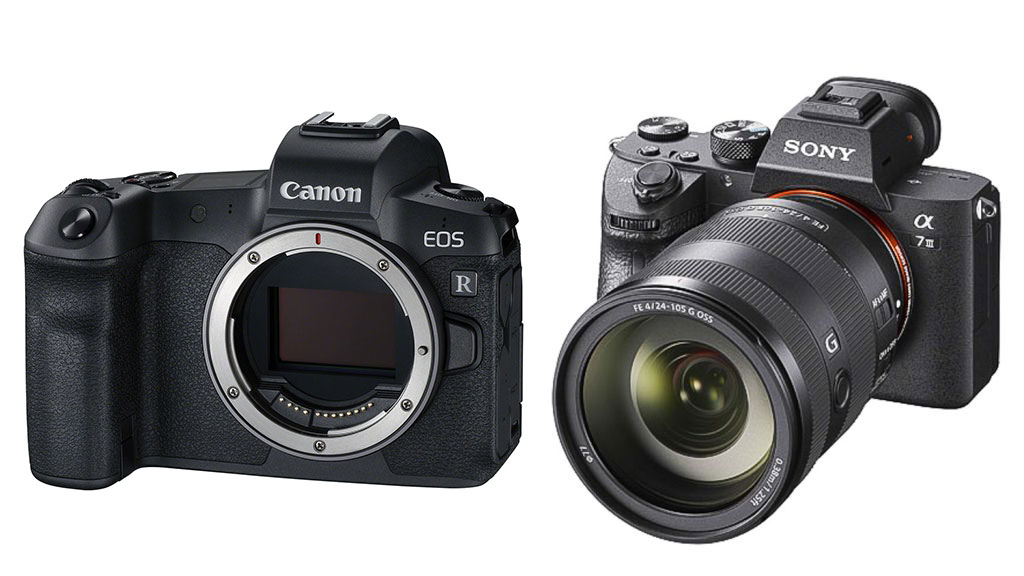
Sony’s full frame mirrorless A7 series series has gone great guns since the get-go, with photographers ditching their bulky and weighty DSLRs and switching to more streamlined mirrorless cameras in increasing numbers. Sony’s A7 Mark III, which we’re looking at here, could itself be viewed as the junior partner of the A7 lineup, but it’s still a formidable option.
Canon, by contrast, could be accused of being rather slow off the mark. Yes, it’s had its APS-C sensor EOS M system for a few years now, but its heart never really seemed in this mirrorless ‘lark’. That is, until the arrival of its full frame EOS R system in late 2018, since then joined by the EOS RP and EOS Ra, with apparently more to come, including a more ‘professional’ example.
While the original EOS R, which we’re comparing here, stands up well against a conventional DSLR, we felt this was more a ‘proof of concept’ than anything else, due to the lack of in-body stabilization and cropped 4K video. More recently, Canon has offered highly-improved models to the series in the shape of the professional EOS R5 and EOS R6.
Despite being the junior model in the Sony A7 lineup, the A7 III remains a competent camera well worth checking out, even if you do already have a collection of lenses for another system entirely.
Yes, on paper this third-generation unit may be the cheapest and least well specified camera in the Sony A7 series; yet, in practice, its price, burst rate and oversampled full width 4K video seek to make it a highly capable all-rounder across a full range of photographic disciplines, and a mighty challenger for the Canon EOS R.
• Canon EOS R vs RP
• Sony A7 vs A7 II vs A7 III
• Sony A7 III vs A7R III vs A7S II
So do you feel the call of the Canon, or are you already sold on Sony? Whichever of these two full frame contenders you choose, we wager you’ll still end up with a result providing you with years of reliable service.
And to help you make that first step towards choosing either the Canon EOS R or the Sony A7 Mark III, we’ve provided a bunch of comparisons in terms of specification and performance. So, to get a sense of which camera will best fit your own particular needs, read on...
Sensor and processor
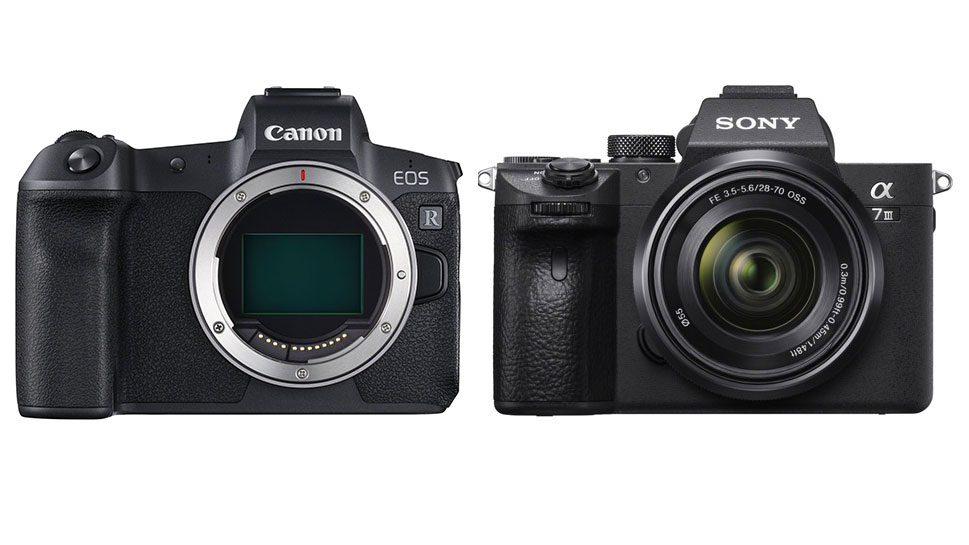
• Canon EOS R: 30.3mp full frame CMOS sensor (36x24mm) and DIGIC 8 processor
• Sony A7 III: 24.2mp full frame Exmor R CMOS sensor (35.6x23.8mm) and BIONZ X processor
Both the mirrorless Canon EOS R and Sony A7 III offer the keen photographer the advantage of full frame photography – meaning that the size of their identically matched sensors is directly comparable to that of a frame of 35mm film. Thus 35mm equivalent calculations become a thing of the past, as the focal length given for the attached lenses is exactly what we get.
Full frame sensors ensure that, in theory, image quality will be noticeably better than that achievable with a standard (smaller) APS-C sensor DSLR – particularly when combined with directly compatible full frame format lenses; E-mount in the case of the Sony and the newer RF mount for the Canon.
While the physical size of the sensor in the Canon EOS R and Sony A7 III may be the same, the resolution we’re getting out of both is different – namely 30.3 megapixels in the case of the Canon and 24.2 effective megapixels for the Sony.
The A7 III features a latest generation BIONZ X processor, while Canon sticks with its tried and tested DIGIC processor, now having arrived at its eighth generation. On paper, at least, the EOS R would seem to have the advantage, but we all know that more pixels on the same sized sensor can result in the appearance of noise at higher ISOs, so it’s something of a trade off.
And, for most circumstances and eventual print sizes, it could be argued that 24 megapixels is already more than enough to deliver photo-realistic results.
However, all that being said, the EOS R’s combination of 30.3MP sensor, DIGIC 8 processor and RF lenses deliver image quality nothing short of formidable.
Read more:
• The best Canon cameras in 2020
• The best Sony cameras in 2020
Video
• Canon EOS R: 4K at up to 29.97fps
• Sony A7 III: 4K at up to 30fps
Sony has a wealth of expertise in video, and it’s no surprise to discover the A7 III offers 4K capture, here at up to 30fps. This is captured across the full sensor width, too, before being down-sampled to 4K resolution, so there are likewise no annoying crop factors here or inefficient pixel binning.
Sony also offers 4K HDR playback on compatible devices via its Hybrid Log Gamma (‘HLG’) profile, and boasts its manufacturer’s own S-Log3 mode for increased dynamic range (up to 14EV).
When we reviewed the Canon EOS R on launch, however, we had a few bones to pick. The real kicker is that 4K footage – at up to an actual frame rate of 29.97 fps – comes with the same 1.7x crop that affects the same manufacturer’s 5D Mark IV DSLR.
However, Canon insists that this makes the sensor almost the same size as its own dedicated Cinema EOS line, so footage from the EOS R will cut seamlessly with that from the likes of its C200 cine camera model. Better news, however, for those looking at this camera as their one and only tool is that the EOS R comes with C-Log as standard, and can record internally at 4:2:0 8-bit with Rec 709 colour space and externally at 4:2:2 10-bit with Rec 2020.
Burst shooting (fps)
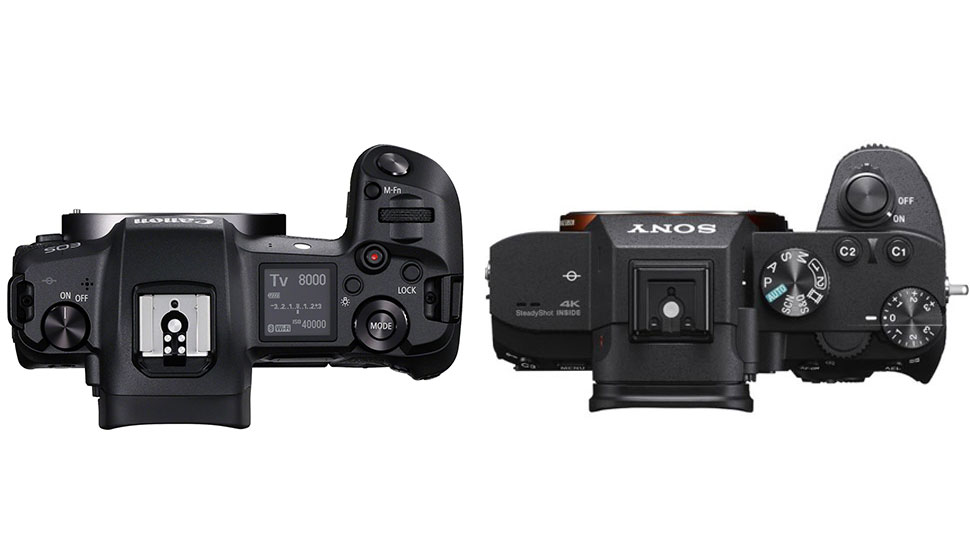
• Canon EOS R: Up to 8fps
• Sony A7 III: Up to 10fps
Both cameras are fairly adept when it comes to burst shooting – making either suitable for sports or wildlife photography. On paper, Sony would seem to have the edge over Canon in offering a maximum 10fps in continuous shooting mode, compared with the EOS R’s slightly lagging behind 8fps. Don’t forget, though, that the Canon boasts a slightly higher resolution overall.
What also looks better for the Sony A7 III is that its maximum 10fps capture rate is double the speed of its Mark II predecessor on launch. Additionally, the Sony A7 III also has a bigger buffer capacity than most enthusiast models, in being capable of capturing up to 40 uncompressed Raw files in a single burst, 89 compressed Raw files, or an even better 177 Jpegs.
We criticized previous models in the series for the inability to use the camera menus once the buffer is full, but Sony has commendably fixed that on the A7 III.
On the Sony A7 III we get the advantage of two card slots to write to – and here we find support for the commonly used SD card too. The Canon only features the one card slot, though there’s the suggestion that future more professionally targeted R system models will address this.
AF system
• Canon EOS R: Dual Pixel AF with 5,655 AF positions
• Sony A7 III: 693 point phase detection AF / 425 point contrast detection AF
Sony has delivered a very impressive AF performance with its A7 III, in incorporating AF technology from its flagship sports camera, the A9. This means we are gifted with a whopping 693 phase detection points covering some 93 percent of the image area. This is backed up with 425 contrast detect AF points, thereby making it one of the most powerful AF systems on the market – on paper, at least.
Auto focus performance has been the battlefield of rival camera manufacturers of late and Sony has done much too with its Eye AF mode, which is obviously a boon for portraits. On the A7 III this feature now works in both continuous plus single shot AF modes. Put simply, the AF system on the Sony is very, very impressive indeed.
Canon, however, has the advantage of its much trumpeted Dual Pixel AF system, which here offers a whopping 5,655 AF positions. These cover 88 percent of the frame horizontally and 100 percent vertically.
On paper, this AF system should be untouchable, but there are a couple of limitations. For starters, out of the box, eye tracking is only possible in single shot AF mode. Plus the auto focus doesn’t appear to be quite as smooth as that of Canon’s top end 1D X Mark II, with which it shares a phase difference detection system. At the time of writing there was some suggestion that such quibbles may be fixed with subsequent firmware updates.
Viewfinder & LCD
• Canon EOS R: Electronic viewfinder with 3.69 million dots and offering 100 percent frame coverage; 3.15-inch LCD with 2,100K dot resolution
• Sony A7 III: Electronic viewfinder with 2,359,296 dots and offering 100 per cent frame coverage; 3-inch LCD with 921,600K dot resolution
Both the Canon EOS R and Sony A7 III offer users an electronic as opposed to optical viewfinder. We raved in our original review of the Canon that it sported probably the best we’ve ever used, finding it to be large, fast, responsive and crystal clear, in part thanks to its best-in-class nearly four million dot resolution.
We even went so far as to suggest that if you are one of those photographers who’s always preferred an optical viewfinder to an EVF, then this might finally be the camera that converts you to the cause.
As noted, by comparison the Sony’s electronic viewfinder and LCD don’t have the highest resolutions we’ve seen in the mirrorless segment. But they are both more than adequate in practice, with the A7 III’s 0.78x magnification meaning that it is at least big and clear.
Its rear LCD also boasts a tilting action, though, unlike on the Canon, it does not swing outwards from the body. You can, however, tap it to direct your focus point, which can even be dragged around the frame. And if you’re not a fan of touch screen interaction, the four-way control pad to the right of the Sony’s LCD can alternatively be used.
By contrast, for those who do prefer using the LCD touch screen, then the Canon EOS R is thankfully fully articulated. So if you are after a flip-out screen, this is the only full frame mirrorless camera on the market at the time of writing that actually has one. Bonus! For both viewfinder and LCD performance then, the Canon EOS R would seem to be the winner of this particular segment.
Build and design
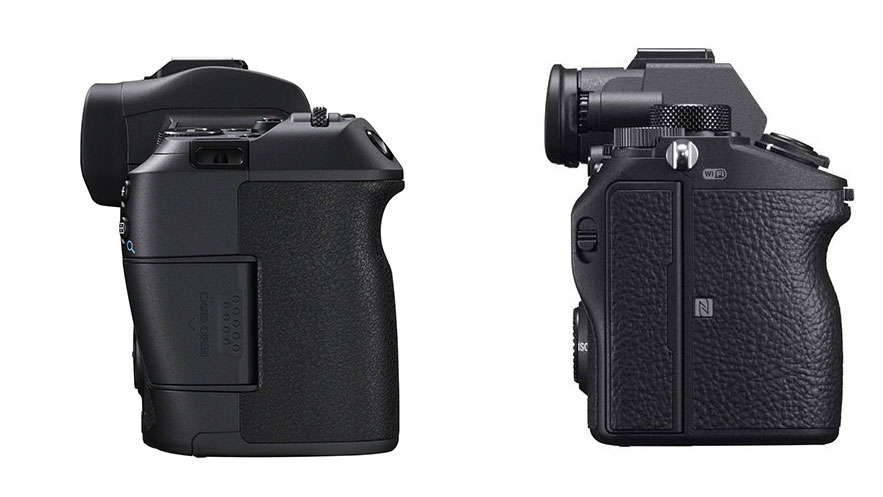
• Canon EOS R: Magnesium alloy and polycarbonate body with glass fibre parts
• Sony A7 III: Magnesium alloy and plastic, weather-resistant construction
If some of the Canon’s inner workings fall a little short of high expectations, the exterior of the EOS R fortunately exceeds them in many regards. The magnesium alloy body screams quality, feeling robust when gripped in the palm, even though it’s more svelte when compared with its maker’s own DSLRs. This can lead to situations where larger lenses threaten to feel unbalanced on the smaller body, though it can be ‘bulked out’ if adding a BG-E22 battery grip. However, should conversely the EOS R feel too bulky, there’s always the more compact EOS RP as an alternative.
Sony’s A7 III is itself remarkably compact for a full frame camera. But it ‘suffers’ from some of the same issues that beset the Canon, namely that its maker’s lenses are not small, leading to the set up occasionally feeling a bit front-heavy when a big lens is fitted. There is, however an optional Sony VG-C3EM battery grip should you want to bulk things up – which may be especially useful if telephoto lens-based sports photography is your bag. It’s a shame, however, that Sony hasn’t included a dedicated drive dial or AF mode/area lever on the A7 III, especially as burst shooting and auto focus are arguably this camera’s top two features.
Weight-wise, the Sony comes in at a manageable 650g, with dimensions measuring 126.9x95.6x73.7mm and a body described as being weather resistant. The electronics giant has long offered image stabilization built into its cameras via its aptly named SteadyShot system, claimed to likewise give a five stop advantage. Results will depend on the shooting conditions, lens used and subject distance – but any image stabilization is better than none at all.
A glaring omission from the Canon EOS R, however, is that there is no body integral anti-shake system at all. Its weight is nigh identical to the A7 III too, at 660g with battery and card but no lens. Dimensions are a slightly larger 135.8x98.3x84.4mm, however.
Other features
We get two SD card slots on the Sony A7 III, and, as noted earlier, with this camera we get the distinct advantage of body integral image stabilization systems, purporting to offer photographers a five-stop exposure advantage. By contrast, this iteration of the EOS R only features one card slot (fortunately for the common SD format) and no in-body anti-shake at all.
Room for improvement here then when it comes to further generations of the camera. Remember though, for comparison purposes, the Sony camera we’re contrasting it with is already in its third generation and several more years down the development line.
Battery life
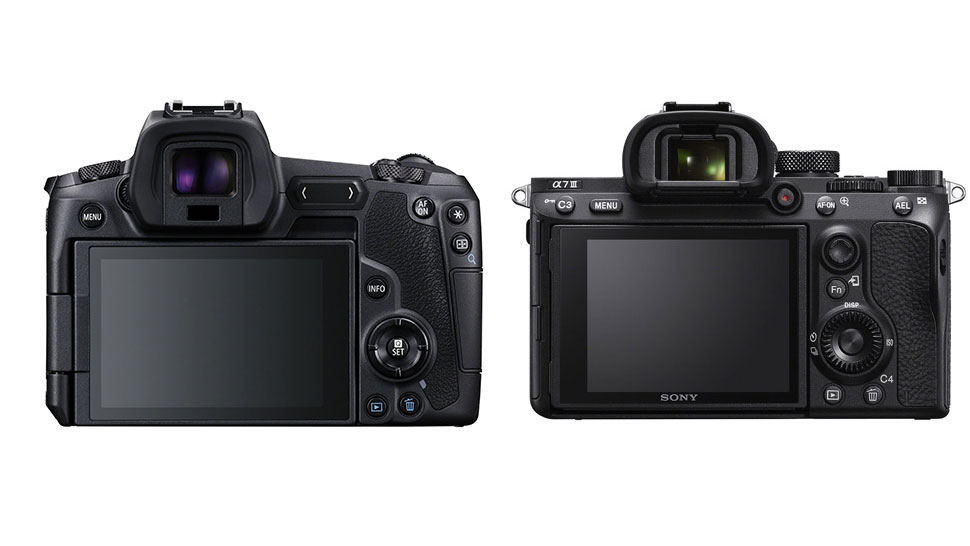
• Canon EOS R: Up to 370 frames per charge of its lithium ion LP-E6N battery
• Sony A7 III: Up to 710 frames per charge of its lithium ion NP-FZ100 pack
We’d expect the power performance of a mirrorless camera to be notably less impressive than that of a DSLR – smaller dimensions normally resulting in a physically smaller battery too – yet we’ve always found the A7 III to buck that trend, as it impressively offers a performance of up to 710 shots from a full charge – double that of most competing mirrorless rivals. Even if exclusively using Sony’s EVF, it still manages to eke out an impressive 610 shots from a fully charged cell.
The Canon EOS R, for its part, offers a maximum battery performance of 370 shots, which, while typical of its class, falls far short of its Sony rival. Don’t forget, however, that optional battery grips for both cameras are available. But, still, if directly compared, then the Sony A7 III wins this particular battle.
Verdict
The Canon EOS R is a pretty effective jack-of-all-trades and is its manufacturer’s current flagship full frame mirrorless, but it lags behind some, including the Sony A7 III here, in terms of cropped 4K video performance, lack of body integral image stabilization plus a lower burst shooting speed.
Yes, the Canon may offer a higher headline resolution, but more pixels don’t always equate with a better camera, or indeed a better picture quality, even if the EOS R’s is very impressive.
By contrast the Sony A7 III ticks most of the boxes where we otherwise take issue with the Canon. It boasts a solid specification and a solid performance, suggesting that if you aren’t already wedded to the Canon brand then it is an option well worth seeking out.
Yes, the EOS R may fare better when compared with a DSLR, but when compared with another long-established mirrorless camera system it appears Canon still has a little catching up to do. It suffers perhaps from being its manufacturer’s first of its type. Fortunately Canon seems to be aware of the fact and is keen to reiterate its commitment to its system of the future. For now though, we’d have to say the Sony is a more solid contender overall and the sensible choice, if free of brand bias and starting building a camera system from scratch.
Read more
Best full-frame mirrorless cameras
The best Sony cameras
The best Sony lenses
The best Canon cameras
The best Canon RF lenses
Get the Digital Camera World Newsletter
The best camera deals, reviews, product advice, and unmissable photography news, direct to your inbox!
Gavin has over 30 years’ experience of writing about photography and television. He is currently the editor of British Photographic Industry News, and previously served as editor of Which Digital Camera and deputy editor of Total Digital Photography.
He has also written for a wide range of publications including T3, BBC Focus, Empire, NME, Radio Times, MacWorld, Computer Active, What Digital Camera and the Rough Guide books.
With his wealth of knowledge, Gavin is well placed to recognize great camera deals and recommend the best products in Digital Camera World’s buying guides. He also writes on a number of specialist subjects including binoculars and monoculars, spotting scopes, microscopes, trail cameras, action cameras, body cameras, filters and cameras straps.

